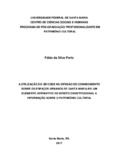| dc.creator | Porto, Fábio da Silva | |
| dc.date.accessioned | 2018-09-04T14:06:12Z | |
| dc.date.available | 2018-09-04T14:06:12Z | |
| dc.date.issued | 2017-06-27 | |
| dc.identifier.uri | http://repositorio.ufsm.br/handle/1/14178 | |
| dc.description.abstract | This work has as objective implement the interdisciplinary study which is meant to serve as foundation to the confection of a product, destinated to be implemented by the municipal public power and by the colectivity, in visible ampliation of the concept of participative citzenship, consistent to the use of technology to ensure the constitucional right of access to information upon cultural patrimony. The research treats about the identification of the existence of the fundamental constitutional right to access to information about cultural patrimony. In this case, beholds the widening of the list of fundamental rights, included effectively in the Federal Constitution of 1988, reconizing the existence of other rights from the same origin, noticiapble trhough the the system’s interpretation. Among those, the right to accsess to information, the right to culture and the right to protection and promotion of cultural patrimony, wich, combined, establish the production of the fundamental constitucional right and of entiltlement of all, consistent at the assurance of obtaining information relative to cultural patrimony. With the intention of giving na eficiente fufilment to this right, displayed by the unitof the Constitution, endevour to insert the patrimonial cultural information in QR codes, that allows the placement of vast informative contente in two-dimensional, that can be, easily, decrypted by photographic câmeras from smartphones or tablets, instantaneously. The territorial option of aplication of the product was the city of Santa Maria/RS/Brazil, as way of assure the local population the abovementioned access to information upon the urban spaces. | eng |
| dc.language | por | por |
| dc.publisher | Universidade Federal de Santa Maria | por |
| dc.rights | Attribution-NonCommercial-NoDerivatives 4.0 International | * |
| dc.rights.uri | http://creativecommons.org/licenses/by-nc-nd/4.0/ | * |
| dc.subject | Informação | por |
| dc.subject | Patrimônio cultural | por |
| dc.subject | Tecnologia | por |
| dc.subject | QR code | por |
| dc.subject | Information | eng |
| dc.subject | Cultural patrimony | eng |
| dc.subject | Technology | eng |
| dc.title | A utilização do QR code na difusão do conhecimento sobre os espaços urbanos de Santa Maria-RS: um elemento afirmativo do direito constitucional à informação sobre o patrimônio cultural | por |
| dc.title.alternative | The utilization of the QR code in the diffusion of knolege with respect to urban spaces of Santa Maria-RS: an afirmative elemento of the constitucional right to information with respect to cultural patrimony | eng |
| dc.type | Dissertação | por |
| dc.description.resumo | O vertente trabalho tem como objetivo apresentar um estudo multidisciplinar que sirva de alicerce na aplicação do produto, destinado a ser implementado pelo poder público municipal e pela coletividade, em visível ampliação do conceito de cidadania participativa, consistente em utilização de tecnologia para assegurar o direito constitucional de acesso a informação sobre patrimônio cultural. A pesquisa cuida da identificação da existência do direito fundamental constitucional de acesso à informação sobre patrimônio cultural. Nesse cenário, observa a dilatação do rol de direitos fundamentais incluídos expressamente na Constituição Federal de 1988, reconhecendo a existência de outros direitos de mesma natureza, perceptíveis através da exegese sistemática. Dentre esses, o direito de acesso à informação, o direito à cultura e o direito à proteção e promoção do patrimônio cultural, que, conjugados, estabelecem a formulação de direito fundamental constitucional e de titularidade de todos, consistente na garantia de obter informações relativas ao patrimônio cultural. No intuito de dar eficaz cumprimento a esse direito, descortinado pela unidade da Constituição, intenta inserir as informações patrimoniais culturais em QR code, que admite a colocação de vasto conteúdo informativo em código bidimensional, que pode ser, facilmente, decodificado por câmera fotográfica de smartphones ou tablets, de forma instantânea. A opção territorial de aplicação do produto foi o município de Santa Maria/RS, como forma de garantir à população local o citado acesso à informação sobre os espaços urbanos e a valorização de seu patrimônio e história. | por |
| dc.contributor.advisor1 | Padoin, Maria Medianeira | |
| dc.contributor.advisor1Lattes | http://lattes.cnpq.br/7863155517478900 | por |
| dc.contributor.referee1 | Ghidolin, Clodoveo | |
| dc.contributor.referee1Lattes | http://lattes.cnpq.br/3147142162161654 | por |
| dc.contributor.referee2 | Cunha, Jorge Luiz da | |
| dc.contributor.referee2Lattes | http://lattes.cnpq.br/7227767555433465 | por |
| dc.creator.Lattes | http://lattes.cnpq.br/8557942101053570 | por |
| dc.publisher.country | Brasil | por |
| dc.publisher.department | História | por |
| dc.publisher.initials | UFSM | por |
| dc.publisher.program | Programa de Pós-Graduação em Patrimônio Cultural | por |
| dc.subject.cnpq | CNPQ::CIENCIAS HUMANAS::HISTORIA | por |
| dc.publisher.unidade | Centro de Ciências Sociais e Humanas | por |



